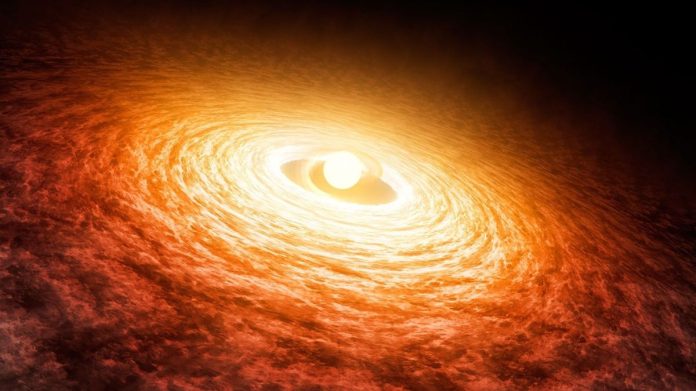
In 1936 astronomers watched as FU Orionis, a dim star in the Orion constellation, brightened dramatically.
The star’s brightness increased by a factor of 100 in a matter of months. When it peaked, it was 100 times more luminous than our Sun.
Astronomers had never observed a young star brightening like this.
Since then, we’ve learned that FU Orionis is a binary star. It’s surrounded by a circumstellar disk and the brightness episodes are triggered when the star accretes mass from the disk.
There are other young stars similar to FU Orionis, and it’s now the namesake for an entire class of variable young stars that brighten in the same manner.
FU Ori stars are a sub-class of T-Tauri stars, young, pre-main sequence stars that are still growing.
Astronomers have modelled FU Ori’s accretion and brightness episodes with some success. But the nature of the disk-star interface has remained a mystery.
Attempts to image the boundary between the two haven’t been successful. Until now.
Astronomers used the Hubble Space Telescope to observe FU Ori with the telescope’s COS (Cosmic Origins Spectrograph) and STIS (Space Telescope Imaging Spectrograph) instruments. Their results are published in The Astrophysical Journal Letters.
The research is “A Far-ultraviolet-detected Accretion Shock at the Star–Disk Boundary of FU Ori” and the lead author is Adolfo Carvalho.
Carvalho is an Astronomy PhD candidate at Caltech.
FU Ori stars are T-Tauri stars that represent the most actively accreting young stellar objects (YSOs). The outward magnetic pressure from T-Tauri stars prevents the disk from touching the star. Astronomers think that classical T-Tauri stars accrete material along their magnetic field lines and deposit on the poles in a process called magnetospheric accretion.
However, FU Ori stars are different. They’ve undergone disk instability either because the disk is so much larger than the star, because of the presence of a binary, or from infalling material. The instability leads to rapid changes in the accretion rate. The increased rate of accretion upsets the balance between the star’s magnetic field and the inner edge of the accretion disk. The spectra of FU Ori stars is dominated by absorption features from the inner disk. Excess emissions from those stars is understood as matter shocking onto the star’s photosphere. However, for FU Ori stars, astronomers are uncertain about the detailed structure of the accretion boundary layer.
The researchers focused on the inner edge of FU Ori’s accretion disk in an attempt to confirm the accretion disk model and understand the boundary layer more completely.
“We were hoping to validate the hottest part of the accretion disk model, to determine its maximum temperature, by measuring closer to the inner edge of the accretion disk than ever before,” said Lynne Hillenbrand of Caltech in Pasadena, California, a co-author of the paper. “I think there was some hope that we would see something extra, like the interface between the star and its disk, but we were certainly not expecting it. The fact we saw so much extra — it was much brighter in the ultraviolet than we predicted — that was the big surprise.”
In FU Ori stars, the accretion disk is closer than in T-Tauri stars. This, combined with the enhanced infall rate, makes them much brighter than T-Tauris. In fact, during an outburst, the disk actually outshines the star. The disk is orbiting faster than the star rotates, and this means there should be a region where the disk impacts the star. The impact slows the material down and heats it up.
The new Hubble UV observations show that the region is there and that it’s much hotter than thought.
“The Hubble data indicates a much hotter impact region than models have previously predicted,” said lead author Carvalho. “In FU Ori, the temperature is 16,000 kelvins [nearly three times our Sun’s surface temperature]. That sizzling temperature is almost twice the amount prior models have calculated. It challenges and encourages us to think of how such a jump in temperature can be explained.”
That means that the scientific model of FU Ori stars, called the viscous disk accretion model, needs to be updated. The team’s revised model says that as material from the accretion disk approaches the star and reaches its surface, it produces a hot shock that emits ultraviolet light. The temperature of the shock suggests that the material is moving at 40 km/s at the boundary, which is in line with simulations of the accretion process.
“The measured temperature and the size of the FUV emission region are consistent with expectations for a shock at the disk–star boundary,” the authors explain in their research. “The shock arises from the collision of the highly supersonic disk surface accretion flow with the stellar photosphere.”
One question scientists have concerns exoplanet formation around young stars. Researchers think that planets start to form when stars are very young. Is this hot flaring a detriment to planet formation? Does it affect their evolution? The extreme UV accretion flaring that FU Ori stars undergo could affect the chemistry of planets.
“Our revised model based on the Hubble data is not strictly bad news for planet evolution, it’s sort of a mixed bag,” explained Carvalho. “If the planet is far out in the disk as it’s forming, outbursts from an FU Ori object should influence what kind of chemicals the planet will ultimately inherit.
But if a forming planet is very close to the star, then it’s a slightly different story. Within a couple outbursts, any planets that are forming very close to the star can rapidly move inward and eventually merge with it. You could lose, or at least completely fry, rocky planets forming close to such a star.”
Written by Evan Gough/Universe Today.



